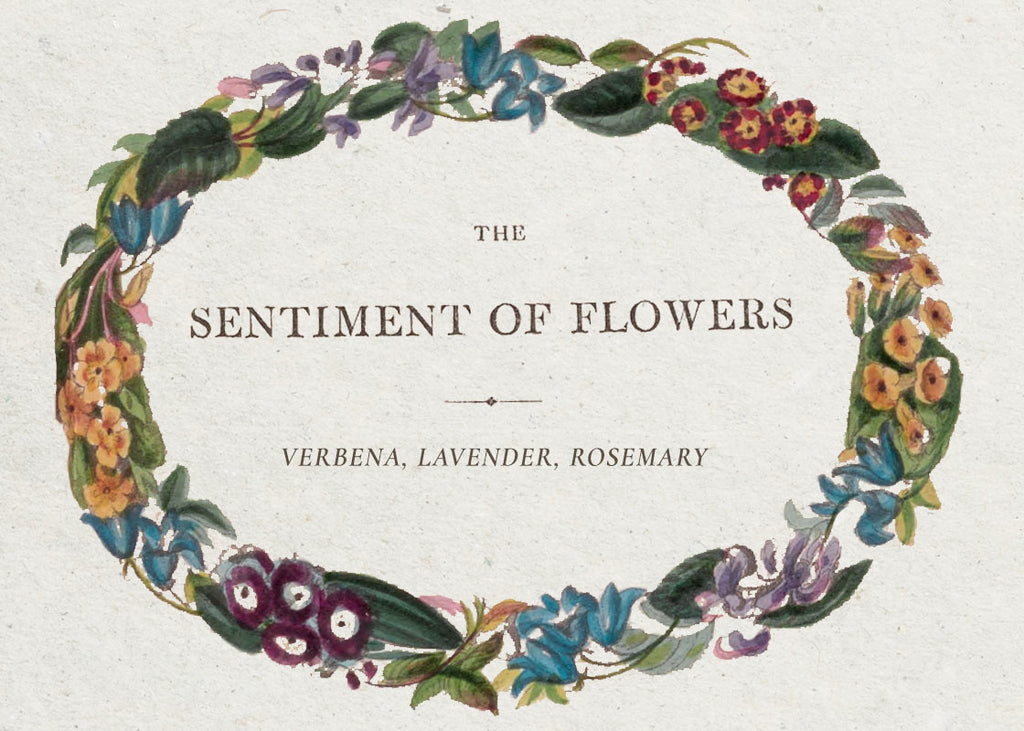Language of Flowers: Verbena, Lavender, and Rosemary
Publié par ADORED VINTAGE le

For the month of October we are exploring the language and sentiment of these three floras: Verbena, Lavender, and Rosemary.
Why you ask? Well dear loves, it is our small homage to one of our most beloved movies of all time, Practical Magic, a movie about sisterhood, friendships, love, and of course a bit of practical magic all set in an idyllic New England town.
Verbena was the name of Sally Owens' beautiful apothecary shop in the movie filled with lotions, balms, and creams she handcrafted with herbs and flowers from her garden. And lavender and rosemary are from the Owens' saying:

"Plant rosemary by your garden gate and lavender for luck..."

VERBENA / VERVAIN
Botanical Name, Verbena hastata
Class, Didynamia / Order, Angiospermia
Flowers, Blue or lavender colored
Native place, America or Europe
Sentiment: You Enchant Me, An Emblem of Enchantment
Origins of Sentiment & Tales of Verbena
Vervain, or wild verbena, has been the floral symbol of enchantment from time immemorial. It was styled "sacred herb" by the Greeks, who ascribed a thousand marvelous properties to it, not the least of which was its power of reconciling enemies.
Verbena was often used in various divinations, sacrifices, and incantations, and its specific name of verbena originally signified a herb used to decorate altars.
It was much valued by the Druids, being regarded by them as only second to mistletoe: they used it largely in their divinations and casting of lots. During the middle ages the sacred character of this herb still reigned paramount and vervain was greatly prized and used in the composition of many charms and love-philtres.
In days of old, in country districts, old folks tie verbena around their necks to charm away the ague, with many it still has the reputation of securing affection from those who take it to those who administer it.
Verbena or vervain, this very common unassuming roadside flower, was the plant of spells and enchantments and still retains its enchanted reputation.

LAVENDER
Botanical Name, Lavandula spika
Class, Didynamia / Order, Gymnospermia
Flowers, Lilac approaching to purple and very fragrant
Native place, Europe and Africa
Sentiment: Acknowledgment of Love & sometimes also symbolizes Distrust
Origins of Sentiment & Tales of Lavender
Shakespeare hath said it, and who would wish to alter an emblem that has become immortal from his adoption?
"She sent him Lavender, owning her love."
We have, therefore, adopted the sentiment.
There are many varieties of lavender but a common trait they all share is every part of the lavender plant is fragrant, some more potent than others. In ancient days the lavender plant was used in bathing and washing, the word lavender deriving from Latin, lavare, to wash.
The French are accountable for its association to mistrust as the fragrance of lavender was often used to mask other unpleasant odors. For centuries lavender has been used as a fragrance either deriving the oils from the lavender plant or simply as dried stems placed in trunks and drawers.

ROSEMARY
Botanical Name, Rosmarinus officinalis
Class, Diandria / Order, Monogynia
Flowers, Purple, growing in an axil
Native place, Europe
Sentiment: Remembrance
Origins of Sentiment & Tales of Rosemary
We are indebted Shakespeare for this junction of flower and sentiment from Ophelia:
"There is Rosemary, that's for remembrance, Pray you, love, remember."
Frequently entwined with laurel and myrtle, rosemary was formed into chaplets, with which the principal personages at feasts were crowned.
In some parts of England during funerals, for a time, it was still customary to distribute it among the company, who frequently threw sprigs of it into the grave and slips of it were sometimes placed within the coffin.
In days of yore, rosemary was in great request at Christmas-tide for decorative purposes, the roast beff was decorated with bays and rosemary. The silvery leaves of this plant mingled well with the glossy holly and yellow-green mistletoe in decking rooms and churches.
During the reign of Queen Elizabeth I, this fragrant herb grew in abundance along the walls of Hampton Court Palace, but then was banished to reside only in the kitchen-gardens.
Now this plant is often cultivated in sweet cottage gardens for bees to resort to and for culinary reasons.
-

Sources: Flower Symbolica by Ingram, John H. 1887 / The Language of Flowers by Saunders & Otley, 1841, London
TAGS










